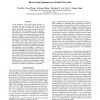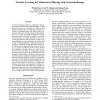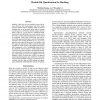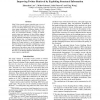AAAI
2012
12 years 1 months ago
2012
This paper describes an emotion-based approach to acquire sentiment similarity of word pairs with respect to their senses. Sentiment similarity indicates the similarity between tw...
AAAI
2012
12 years 1 months ago
2012
As the popularity of the social media increases, as evidenced in Twitter, Facebook and China’s Renren, spamming activities also picked up in numbers and variety. On social netwo...
AAAI
2012
12 years 1 months ago
2012
To solve the sparsity problem in collaborative filtering, researchers have introduced transfer learning as a viable approach to make use of auxiliary data. Most previous transfer...
AAAI
2012
12 years 1 months ago
2012
Widespread accounts of the harmful effects of invasive species have stimulated both practical and theoretical studies on how the spread of these destructive agents can be containe...
AAAI
2012
12 years 1 months ago
2012
Hashing, which tries to learn similarity-preserving binary codes for data representation, has been widely used for efficient nearest neighbor search in massive databases due to i...
AAAI
2012
12 years 1 months ago
2012
Given a monochrome image and some manually labeled pixels, the colorization problem is a computer-assisted process of adding color to the monochrome image. This paper proposes a n...
AAAI
2012
12 years 1 months ago
2012
We tackle the problem of defining a well-founded semantics (WFS) for Datalog rules with existentially quantified variables in their heads and negations in their bodies. In partic...
AAAI
2012
12 years 1 months ago
2012
Most Twitter search systems generally treat a tweet as a plain text when modeling relevance. However, a series of conventions allows users to tweet in structural ways using combin...
AAAI
2012
12 years 1 months ago
2012
We explore the problem of assigning heterogeneous tasks to workers with different, unknown skill sets in crowdsourcing markets such as Amazon Mechanical Turk. We first formalize ...
AAAI
2012
12 years 1 months ago
2012
In AI research, mechanism design is typically used to allocate tasks and resources to agents holding private information about their values for possible allocations. In this conte...





